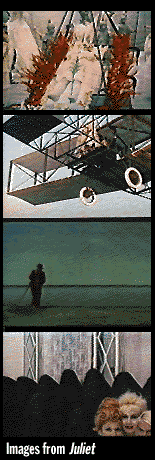
Introduction
I first encountered Fellini's film imagery at an age far younger than the MPAA ratings board would likely approve. Flipping past WTTW, the Chicago PBS affiliate, my eye and imagination were captured by an unexpected parade of bizarre images and characters (and scantily-clad women). Young girls chained to flying beds, a kindly eccentric in a flying machine, phantoms slipping in and out of the periphery — these were the images that caught my attention and stayed with me into adulthood. I took note of the film's title then — Juliet of the Spirits.
In later years, I would view Juliet again and go on to discover 8-1/2. Again, the imagery took root in memory, even while details of plots and themes faded away. In viewing these and others of Fellini's films today, I am still struck by the images — some wildly imaginative, others richly textured, many presenting blurred juxtapositions of memory, fantasy and reality. Yet the images now strike a deeper chord... the images and the sometimes extreme characters who populate them seem to resonate with unexpected familiarity. Fellini builds these intentionally two-dimensional characters into archetypal figures, playing to my (often suppressed) personal memories, fantasies and biases.
To explore this further, I will examine Fellini's archetypes in five films — La Dolce Vita, 8-1/2, Juliet of the Spirits, La Strada and City of Women. Certain figures and images recur in many of these films, as Fellini repeatedly explores the roles and interrelationships between men and women, husbands and wives, parents and children. Select one of the archetypes in the image below for additional discussion.

Looking for more Fellini?
Read Roger Ebert, on Fellini’s
8 1/2 and La Dolce Vita.




